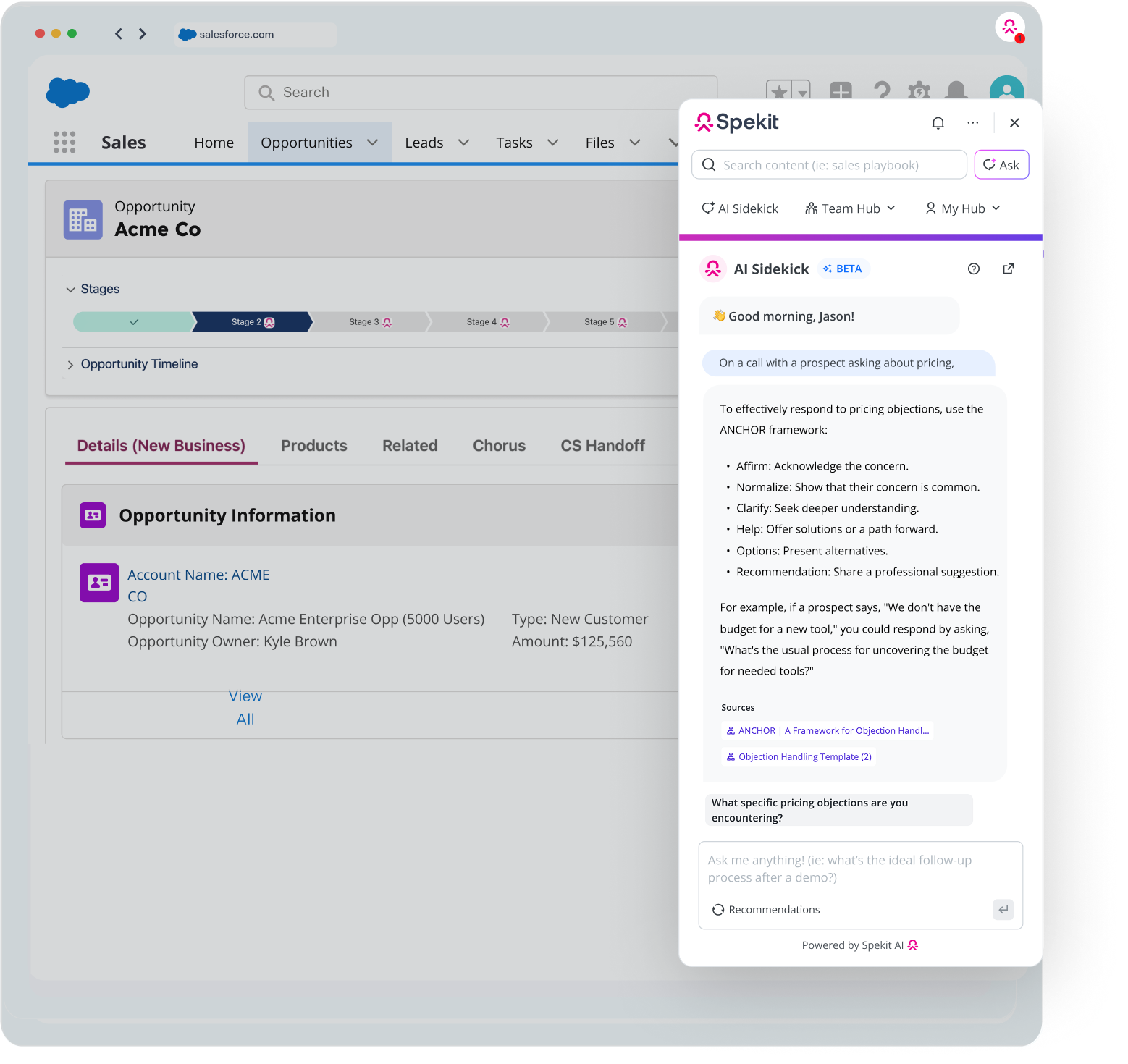You could build a massive library of sales content but if it isn’t accurate, trusted, and instantly accessible in the flow of work, it won’t move revenue.
Sales reps now have plenty of to leverage during buyer interactions but they still have to hunt for most of it themselves. , a sales rep has 1400 sales assets to choose from. Yet, the vast majority off these assets go unused because they’re spread across multiple content repositories.
It’s also quite common for reps to lose deals because they’re struggling to find sales content that's relevant to a prospect. The solution to this problem is effective sales content management: maintaining a single content repository with updated, organized, and easy-to-access information.Â
Modern sales content management focuses on relevance, delivery, and outcomes: keeping content current by design, surfacing the one best answer in under 30 seconds, and connecting usage to pipeline, win rates, and time to close.
In this article, you’ll understand the benefits and challenges of sales content management and how to improve your sales content management strategy to drive revenue growth.Â
What is sales content management?
Sales content management is the discipline of creating, organizing, governing, and delivering sales materials so reps can act with clarity at every stage of the deal.
It goes beyond storage. The modern approach unifies a governed content layer (syncing sources like Drive, SharePoint, and Confluence) with proactive delivery, in the flow of work, across CRM, email, chat, and call tools so the right snippet appears where work happens, not in a separate portal.
Sales content vs marketing content
Sales content is created for the decision stage of a buyer’s journey. It’s specific information about your business, product, and services designed to convince a prospect of your product’s and how your product features can help solve their problems.Â
Marketing content, on the other hand, focuses on the awareness and consideration stage of the buyer journey. It is information that points prospects to answers they need concerning how a potential product (not necessarily yours) and its features work. Examples of marketing content might be blog posts, free ebooks, infographics, etc.Â
While sales teams often create their own content, they also rely heavily on marketing collateral management software to access and share these marketing-created materials with prospects.
Sales content is created to persuade prospects, while marketing content provides a wide variety of information that can help prospects achieve their goal.Â
Sales content examples
Let’s look at three that help sales reps turn prospects into customers:Â
Sales Playbooks

Short, scannable “how we win” guides aligned to key motions (prospecting, discovery, security review, proof, commercial negotiation).
, only 21% of a rep's day is spent selling. Making it easy to access sales playbooks can help free up valuable time for reps, enabling them to focus more on selling.Â
Sales Processes

The sales process is a set of predetermined steps that reps follow to convert leads into customers. Top sales reps typically spend finding and researching prospects.Â
Sales process documents such as the from şÚÁĎłÔąĎÍř help to streamline their efforts. These documents provide information on how reps can identify and find potential buyers, how to approach prospects to present sales content, handle objections, and close deals.Â
Prospecting Tips

Prospects are leads whose needs match your product offerings and who have shown interest in your product. generate more sales meetings via prospecting because they are armed with the best prospecting tips. A prospecting tip provides sales reps with the information they need to drive the prospects' interest and turn them into customers.Â
Prospecting tips outline strategies, or tricks reps can use when reaching out to potential customers through cold emailing, cold calling, business networking, etc. It enables them to define their target market, leverage sales prospecting tools, conduct discovery calls, and follow up with prospects.Â
Benefits of sales content management
The benefits of sales content management are numerous. Let’s look at some:
Easier Content CreationÂ
Sales content management simplifies the entire content creation process since marketing and sales teams have accurate insights and information on what prospects need and how to deliver value to them.Â
Also, since sales materials are organized and accessible, they can easily notice content gaps and create sales content to fill in those gaps. This ensures content is never repeated and is always up to date.Â
Improved Sales Team ProductivityÂ
Sales reps and teams on non-selling activities. This is because they search for information or create content when they don’t find what they need. Sales content management aggregates all the needed materials in one place, making sales content readily accessible so your sales team has more time for revenue-generating activities.Â
Better Content Usage by Employees & Prospects
Sales content management helps you aggregate sales materials on one platform, and segment materials into categories like content type, buyer sales, and sales cycle stage. Following content structure guidelines ensures that sales teams can efficiently organize and distribute materials, making it easier for reps to find and share relevant content with prospects.Â
For prospects, they receive content that’s useful and can help them solve their problems. This increases buyer engagement and conversions.Â
Supports Revenue & Sales EnablementÂ
Sales content management allows you to equip sales and revenue teams with the content, knowledge, required to close deals and drive revenue. A central content repository reduces search time and speeds up the sales cycle.Â
Personalizing sales content enables sales reps to deliver tailored pitches, and analytics offer insight into content effectiveness, helping revenue teams develop strategies that optimize content and increase the ROI of sales materials.Â
Challenges of sales content management
Sales content management is only effective when you have content management practices in place. Without it, you might run into some issues…
Old or inaccurate contentÂ
, 89% of B2B buyers want relevant content and it must be accurate and current.
The fastest way to keep pace is to take updating out of spreadsheets and into the flow of work with şÚÁĎłÔąĎÍř AI. Instead of hunting across folders, şÚÁĎłÔąĎÍř AI can generate or refresh bite-sized content from source materials (decks, PDFs, Confluence pages), propose “what changed” summaries, and flag duplicates or stale assets automatically.
When you’re in Salesforce (or Gmail/Outlook, Slack, or your browser), open şÚÁĎłÔąĎÍř AI Sidekick and it will suggest the right snippet to create or update or draft the new copy from your linked sources.
Updates cascade instantly to every place that content appears, and targeted in-app alerts notify reps at the moment of need.
The result: trustworthy, governed content that stays fresh by design and answers that reach reps in under 30 seconds.
Time-consuming to find contentÂ
searching for information. That’s a lot of time spent searching for content when they should engage prospects and sell. Finding the right sales material for a prospect is difficult when content is scattered across different platforms.Â

Effective sales content management requires you to provide a central hub, such as a sales content management software, that integrates your sales team's tech stack. You should be able to centralize your knowledge, collateral, and training to curate content playlists for every enablement need, from onboarding and product launches to deal rooms.
Using şÚÁĎłÔąĎÍř's AI Sidekick feature allows you to surface the right marketing content to sales reps exactly when and where they need it to 10x engagement and impact. You'll be able to:
- Strengthen rep effectiveness by surfacing the most relevant, high-performing content at each deal stage
- Automatically turn your content into instant answers, messaging guidance or email templates for your reps in any tool
- Alert reps of new content when it's the most relevant to them (not in that newsletter that doesn't get read)
Hard to track content usage
Despite the excess of sales content available to sales teams, of it goes unused. That’s a huge number.Â

Sales reps reach out to many prospects daily and don’t have time to track what sales content they use for each prospect. And, having sales materials spread on various platforms makes tracking even harder.Â
To effectively manage sales content, you need a sales content management tool with, which provides reporting insights and analysis that help you uncover content usage gaps.Â
şÚÁĎłÔąĎÍř analytics provide a real-time look at what content is popular, getting reactions, out of date, and more. These actionable insights are shared on easy-to-read dashboards that report on content engagement, use, and governance.
How to improve your sales content management
Ensure your sales content is being used effectively with these strategies:Â
1. Assess your current sales content
Performing content audits is critical in sales content management. It's important to assess current sales content periodically. that assess sales content regularly see increased engagement. Â
Assessing sales content provides answers to questions you may have, like: what content is being used? What content is outdated? What content drives the most engagement or conversions? These insights are needed to optimize the creation and delivery of sales content.Â
2. Align your sales & marketing teamsÂ
Alignment between sales and marketing teams is important for seamless sales content management. It contributes to increased closed deals by creating a better communication pattern from marketing to sales and vice versa, optimizing the sharing of ideas, strategies, and feedback on sales content.Â
For example, your marketing team can use feedback from the to create and update sales content to ensure it is aligned with what prospects need.Â
3. Track content effectivenessÂ
Marketing and sales teams often spend a lot of resources and time creating and delivering sales materials with zero insights as to whether they are effective. Tracking content effectiveness helps you understand if sales materials are useful to sales reps.Â
It also lets you know what sales content resonates most with your target audience or prospects and what content gaps need to be filled to close deals and increase sales.Â
4. Use sales content management tools
Sales content management tools reduce the level of manual effort required to manage sales content. For instance, integrating your sales materials with cloud storage solutions can streamline access — one option is to connect with Google Drive to ensure your sales team can find and share content effortlessly. These tools streamline sales processes and simplify workflow by automating tasks like managing user access to content, aligning sales and marketing teams, performing content audits, tracking content effectiveness, and following proper content upload steps.
What is a sales content management system (Sales CMS)?
A sales content management system organizes and stores all sales-related content. It serves as a central hub that aggregates siloed content in one place and enables sales leaders to control who has access to materials on the platform. A Sales CMS optimizes your content management through:
Collateral organization & deliveryÂ
complain about not locating sales content to share with prospects. Sales CMS enables you to set up sales collateral categories depending on sales needs throughout the sales cycle, ensuring that teams can efficiently organize and distribute materials.
Users can also group collateral according to the buyer’s journey and automate content delivery to prospects when needed. This effectively reduces the time spent locating content and ensures the delivery of relevant sales collateral to every prospect.Â
Tech stack integrations
Sales teams use a collection of and tools to manage and regulate their workflows. They often have to manually send information from one platform to another. Sales CMS is an all-in-one solution for integrating your sales team's tools. It allows you to automate workflows and synchronize data across platforms.Â
Analytics & reportingÂ
Sales CMS analytics and reporting tools enable you to track and measure the performance of all your sales collateral. You can analyze metrics like customer behavior, engagement, conversions, and ROI of sales content to understand what is and isn’t working.Â
analyzing metrics increases the success of sales efforts. Sales CMS offers a data-driven approach to monitoring sales content effectiveness and creating custom reports.Â
User permissions
User permissions allow you to specify the level of capabilities and access for your sales team. With Sales CMS, you can create user groups and designate permissions for each group. For example, you can create a group for users who create sales content and allow them only to create but not share content.Â
This feature ensures that everyone in your sales team only has access to what they need to perform their duties. In addition, you can set up permissions to allow different users to work together, enabling effective collaboration amongst teams.Â
Transform your sales content management
If your “content management” still means hunting through folders, it’s time to modernize.
Centralize your approved content, govern it by design, deliver it in-flow with AI recommendations, and measure impact on pipeline and revenue, not just views.
That’s how teams reduce ramp time, increase win rates, and create consistent execution across every rep and every deal. See how easy it is to get started today.







